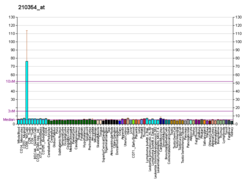IFN-g
| IFNG |
|---|
 |
|
| Identifiers |
|---|
| Aliases |
IFNG, IFG, IFI, interferon, gamma, interferon gamma |
| External IDs |
MGI: 107656 HomoloGene: 55526 GeneCards: IFNG |
|
| Gene location (Mouse) |
|---|
 |
| Chr. |
Chromosome 10 (mouse) |
|
| Band |
10 D2|10 66.75 cM |
Start |
118,441,046 bp |
| End |
118,445,892 bp |
|
|
| Gene ontology |
|---|
| Molecular function |
• interferon-gamma receptor binding
• cytokine activity
• protein binding
|
| Cellular component |
• extracellular region
• external side of plasma membrane
• perikaryon
• neuron projection
• cytoplasm
• extracellular space
|
| Biological process |
• apoptotic process
• positive regulation of MHC class II biosynthetic process
• negative regulation of smooth muscle cell proliferation
• cellular response to interleukin-18
• movement of cell or subcellular component
• antigen processing and presentation
• positive regulation of fructose 1,6-bisphosphate 1-phosphatase activity
• regulation of transcription, DNA-templated
• positive regulation of tumor necrosis factor (ligand) superfamily member 11 production
• positive regulation of interleukin-12 production
• negative regulation of growth of symbiont in host
• positive regulation of autophagy
• positive regulation of smooth muscle cell apoptotic process
• positive regulation of chemokine biosynthetic process
• regulation of insulin secretion
• extrinsic apoptotic signaling pathway
• regulation of the force of heart contraction
• regulation of neuronal action potential
• positive regulation of nitric oxide biosynthetic process
• protein import into nucleus, translocation
• positive regulation of synaptic transmission, cholinergic
• response to virus
• positive regulation of membrane protein ectodomain proteolysis
• positive regulation of epithelial cell migration
• positive regulation of osteoclast differentiation
• positive regulation of killing of cells of other organism
• positive regulation of calcidiol 1-monooxygenase activity
• positive regulation of peptidyl-serine phosphorylation of STAT protein
• negative regulation of transcription from RNA polymerase II promoter
• positive regulation of vitamin D biosynthetic process
• positive regulation of interleukin-6 biosynthetic process
• neutrophil chemotaxis
• negative regulation of gene expression
• positive regulation of fructose 1,6-bisphosphate metabolic process
• positive regulation of transcription, DNA-templated
• endoplasmic reticulum unfolded protein response
• positive regulation of interleukin-12 biosynthetic process
• cell surface receptor signaling pathway
• negative regulation of growth of symbiont involved in interaction with host
• positive regulation of gene expression
• regulation of interferon-gamma-mediated signaling pathway
• defense response to bacterium
• defense response to virus
• positive regulation of interleukin-1 beta secretion
• positive regulation of neuron differentiation
• positive regulation of T cell proliferation
• cell cycle arrest
• positive regulation of cell proliferation
• regulation of hepatocyte proliferation
• immune response
• regulation of immune response
• positive regulation of tumor necrosis factor production
• CD8-positive, alpha-beta T cell differentiation involved in immune response
• neutrophil apoptotic process
• sensory perception of mechanical stimulus
• regulation of growth
• positive regulation of isotype switching to IgG isotypes
• positive regulation of exosomal secretion
• positive regulation of CD4-positive, CD25-positive, alpha-beta regulatory T cell differentiation involved in immune response
• negative regulation of interleukin-17 production
• cellular response to lipopolysaccharide
• T cell receptor signaling pathway
• negative regulation of epithelial cell differentiation
• negative regulation of myelination
• inflammatory cell apoptotic process
• positive regulation of interleukin-23 production
• response to drug
• positive regulation of transcription from RNA polymerase II promoter
• negative regulation of cell proliferation
• defense response to protozoan
• positive regulation of cell adhesion
• negative regulation of glomerular mesangial cell proliferation
• negative regulation of fibroblast proliferation
• regulation of glial cell proliferation
• positive regulation of apoptotic process
• positive regulation of protein phosphorylation
• adaptive immune response
• humoral immune response
• regulation of protein ADP-ribosylation
• positive regulation of protein complex assembly
• positive regulation of protein import into nucleus, translocation
• positive regulation of tyrosine phosphorylation of STAT protein
• negative regulation of transcription, DNA-templated
• regulation of defense response to virus by host
• interferon-gamma-mediated signaling pathway
• positive regulation of protein serine/threonine kinase activity
• positive regulation of protein deacetylation
• positive regulation of core promoter binding
• interleukin-12-mediated signaling pathway
• regulation of regulatory T cell differentiation
• positive regulation of protein localization to plasma membrane
• regulation of receptor activity
|
| Sources:Amigo / QuickGO
|
|
| Orthologs |
|---|
| Species |
Human |
Mouse |
| Entrez |
|
|
| Ensembl |
|
|
| UniProt |
|
|
| RefSeq (mRNA) |
|
|
| RefSeq (protein) |
|
|
| Location (UCSC) |
Chr 12: 68.15 – 68.16 Mb |
Chr 10: 118.44 – 118.45 Mb |
|
PubMed search |
|
|
|
|
1EKU, 1FG9, 1FYH, 1HIG, 3BES
3458
15978
ENSG00000111537
ENSMUSG00000055170
P01579
P01580
NM_000619
NM_008337
NP_000610
NP_032363
Interferon gamma (IFNγ) is a dimerized soluble cytokine that is the only member of the type II class of interferons. The existence of this interferon, which early in its history was known as immune interferon, was described by E. F. Wheelock as a product of human leukocytes stimulated with phytohemagglutinin, and by others as a product of antigen-stimulated lymphocytes or tuberculin-sensitized mouse peritoneal lymphocytes challenged with PPD; the resulting supernatants were shown to inhibit growth of vesicular stomatitis virus. Those reports also contained the basic observation underlying the now widely employed interferon gamma release assay used to test for tuberculosis. In humans, the IFNγ protein is encoded by the IFNG gene.
...
Wikipedia







